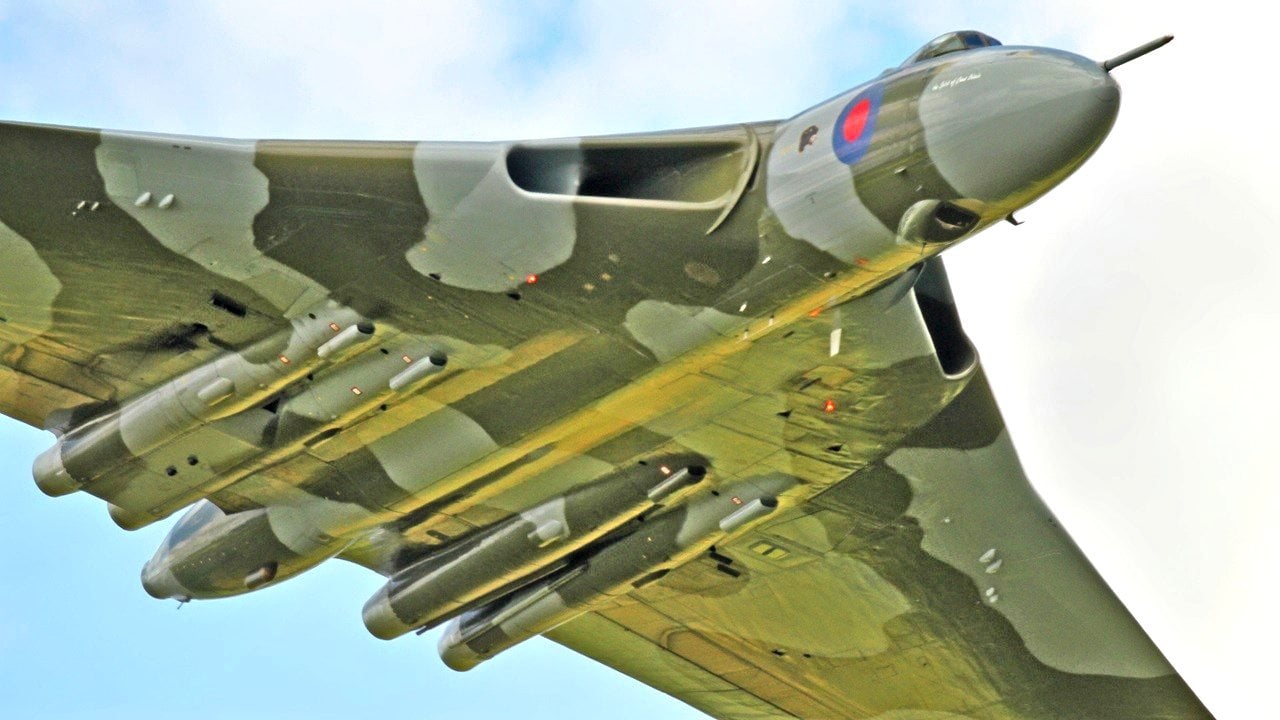The Avro Vulcan Bomber Was Built for a Russia War That Never Happened
The UK introduced the Avro Vulcan bomber shortly after WWII, serving as a key component of its Cold War nuclear deterrent.
Summary: The UK introduced the Avro Vulcan bomber shortly after WWII, serving as a key component of its Cold War nuclear deterrent.

-Designed by Avro with a distinctive delta-wing, the Vulcan's first prototype flew in 1952. Entering service in 1956, it boasted advanced radar evasion capabilities and was initially nuclear-capable.
-The Vulcan gained fame during the 1982 Falklands War with long-range bombing missions.
-Despite limited use in the Cold War, it proved versatile and influential, supporting NATO and influencing future aircraft designs.
Avro Vulcan: The UK's Cold War Deterrent and Falklands Hero
The U.S. and USSR were not the only nations to prioritize advanced new armaments during the Cold War. Positioned closer than the U.S. to the Soviet Union, the United Kingdom also built up its aerial arsenal.
The UK introduced its Avro Vulcan bomber just days after the end of the Second World War. This jet-powered, tailless, delta-wing aircraft would become the UK’s nuclear bomber during the Cold War. In addition to serving as a deterrent against the Soviets, the Vulcan would later carry out the longest bomber raid in history during the 1982 Falklands War.
The History of the Vulcan Bomber
Britain’s Vulcan aircraft was derived from the country’s atomic weapons program. In the mid-1940s, officials authorized the research and development of atomic weapons, specifically one that could be released from up to 50,000 feet. Avro ultimately was selected to create the bomber capable of deploying such a weapon.

The company’s chief designer, Roy Chadwick, introduced an atypical design based on a delta-wing concept. In order to gain technical data for this radical design, more than one Vulcan prototype was created. One of these “mini Vulcans,” Type 698 VX770, was eventually selected.
This bomber took its maiden flight in 1952, powered by Avon engines, as its intended Bristol Olympus engines were not quite ready for service. The prototype made a public appearance at an air show the same year, during which the bomber demonstrated a near vertical bank.
In 1953, a second Vulcan prototype took to the skies. The VX777 was soon refitted with Olympus 101 engines and continued its testing phase. However, the bomber’s tendency to enter an uncontrollable dive while in flight made it not ideal for service. In order to rectify this shortcoming, the wings were redesigned, with an auto-mach trimmer installed to prevent uncontrolled dives. The 698 would later be redesignated as the Vulcan by the Air Council.
When the Vulcan officially entered service in 1956, it required a five-man crew for operation. The Vulcan arguably had the lowest radar cross section ever when it first flew, meaning it was difficult for enemy aircraft to detect.
The Falklands Campaign
The Vulcan was ahead of its time in terms of armaments. The bomber’s internal weapons bay could carry twenty-one 1,000-pound bombs when operating in its conventional strike mode. Additionally, the Vulcan could carry Shrike anti-radar missiles, which would be used during the Falklands campaign.

As detailed by Avro Vulcan, “Between 30 April and 11 June, the RAF carried out five long-range sorties against the Falklands with Vulcans detached to Wideawake Airfield, on Ascension Island, in the mid-Atlantic. Code-named Operation ‘Black Buck’, three of the sorties were conventional bombing missions against the runway at Port Stanley Airport (in order to deny its use to high-performance Argentinean fighters) and two were Shrike missile sorties against radar sites on the islands. The raids were the longest bombing missions in the history of aerial warfare (a record subsequently broken by USAF B-52 s during the 1990 Gulf War), each requiring massive support from the RAF’s fleet of Victor K2 tankers. Each ‘Black Buck’ involved a round trip of some 8,000 miles and lasted upwards of 15 hours.”
While the Vulcan was used sparingly during the Cold War, the bomber certainly proved its worth during the Falklands campaign. An improved B2 variant was later designed that was able to carry the Blue Steel nuclear stand-off bomb. Following their withdrawal from the nuclear deterrent in 1970, however, the Vulcans switched to a conventional bomber role in order to support NATO allies in Europe.
The Vulcan perhaps represents the pinnacle of British aerial innovation in the post-WWII era. This unique bomber likely influenced the flying-wing shapes of future aircraft.
About the Author: Maya Carlin
Maya Carlin, National Security Writer with The National Interest, is an analyst with the Center for Security Policy and a former Anna Sobol Levy Fellow at IDC Herzliya in Israel. She has by-lines in many publications, including The National Interest, Jerusalem Post, and Times of Israel. You can follow her on Twitter: @MayaCarlin.
All images are Creative Commons.


